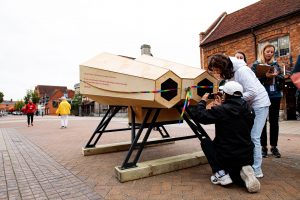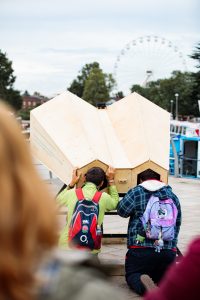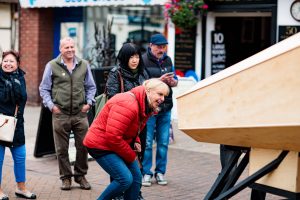Inspired by the Playable City commissions that have already taken place around the globe, we set out to commission an original artwork to be situated in public spaces within Stratford-upon-Avon town centre that would mark the 250th anniversary of Garrick’s Shakespeare Jubilee, and respond to the body of research accumulated through my Development Grant project.
The Shakespeare Jubilee was the first ever celebration of Shakespeare in Stratford. It took place in 1769, organised by actor, director and pre-eminent Shakespearean David Garrick who had been invited by the town to unveil a new statue of Shakespeare. Although much of the weekend’s festivities were cancelled due to heavy rain, it is now seen as the event that began the tourism industry in Stratford. Those 3 days entirely changed the future of this small market town. The town’s residents took the opportunity to rent out their sheds and chicken coops to the well-to-do of London, in a place entirely unprepared and unsuitable to host an event of this scale. Today, it is visited by over 4m people a year, with tourism generating an annual business turnover of approx. £630m and supporting over 11,000 jobs – mine included!
Contrasting with this, the town has approximately 30,000 residents, and as explained in this previous post, my research sought to understand how residents feel about the town they lived in. Do they feel connected to the town’s world-famous story? How do they see the town’s contemporary identity? The findings indicated a substantial feeling of Shakespeare being ‘for visitors or tourists’. Many respondents talked about the town’s decision makers placing more emphasis on the needs of visitors, rather than those of residents, and seeing this reflected in problems like traffic congestion, overpriced housing and commercial rents, litter, homelessness, and a lack of facilities and opportunities for young people. However, the findings also suggested a great sense of pride and a love for the town amongst its residents.
In my mind, there was a serendipitous meeting of the anniversary of the Jubilee and the results of the research. The two organisations had always intended to mark this important anniversary in the town. It felt so important that the celebration was a moment for local people. But if those local people are disenfranchised from the very word Shakespeare, what could that mean for our celebrations?
We created a brief drawing on both aspects, asking for a project that would activate local people’s engagement and intervention in their home town, taking the energy and spirit created by the Jubilee as both benchmark and inspiration. We invited six shortlisted artists/companies to make proposals in response to this brief. The artists all received a fee for their time and were invited to a research day in Stratford where we gave them a tour of the town, our public spaces and an introduction to the SBT museum and archive collections. This included items from the Jubilee, including a rainbow ribbon that was created for the celebrations, some of Garrick’s writings, and first-hand accounts of the event. We felt it was important for the artists to understand the history of this moment, and how significant it was. Physical items from a collection can speak loudly and be a great source of inspiration.
I began my CPI journey working for the RSC, one of the partners of the programme – and approximately half way through moved to a new role at SBT. This created great conditions for two organisations to collaborate on this project, and Geraldine Collinge (Director of Events & Exhibitions, RSC) and I used the opportunity of going to Tokyo together to shape our planning and the brief. A broader group came together to create an evaluation framework using the network – values – impacts – benefits model shared with the CPI cohort by Jonathan Dovey and Simon Moreton, and the same group interviewed the six artists/companies.
We were really pleased with the range of proposals, the response to the brief and strength of ideas. We scored the proposals on a matrix based on the criteria in the brief and the values we had articulated. The same matrix was used by a group of my CPI peers (Kate Stewart, Russel Hlongwane and Sarah Brin, alongside Pete Vance) whose external perspective, differing views and technical expertise, contributed to a more robust process and richer, more informed discussion in Stratford.
We interviewed all six artists and then had a follow-up discussion, at which I relayed the feedback of the peer group. The decision to commission Anagram’s project I See the Future was unanimous. Their idea was to site sculptures, resembling giant pairs of binoculars, in the town’s public spaces. Inside the binoculars, layered over real time footage of the location, would be animated films reflecting a future for the town, in 100 years, imagined by residents. The process for gathering the content of these films would be a series of workshops with local people. Going back to the brief, we felt the idea was a clear provocation for change, but through a process that would draw on play and imagination. 100 years into the future felt far enough to allow our participants to dream, and to not be drawn into just expressing current frustrations and possible solutions. The binoculars themselves would disrupt the heritage streets of the town and create a point of difference and spectacle, surprising people and allowing them to play in public space and put themselves in the picture.

We made our selection and embarked on the project, with the first priority being the delivery of the workshops. It should be noted that neither Stratford organisation has a full-time community officer or outreach department; both have delivered community projects and found it challenging to engage local participants in projects. In conversations, SBT and RSC felt that a breadth of participants of different ages and backgrounds was desirable, and therefore felt we needed both drop-in or open workshops, and closed sessions for specific groups. Anagram prioritised a depth of engagement and closed workshops; but in practice getting groups to sign up to these was challenging and in the end only one such session took place. This was an excellent session in which some great content was created for the animations.
Through open workshops in front of the Royal Shakespeare Theatre and in the RSC’s pop-up shop on the High St, we did reach a diversity of participants of a range of ages and interests, but not as many as we had hoped for. The pop-up shop was a great opportunity to profile the project across the Summer in a prominent, open town centre location. It required a simple activity to engage people in the project, and this led to the creation of a postcard which also acted as both marketing for the installation. It asked people to respond to questions about their hopes or visions of the future, with writing and drawings. Completed postcards were then displayed on the main back wall of the shop.
Whilst I felt the challenge of managing the multiple stakeholders all the way through the project, my history of working at the RSC, and the close working relationship of the two organisations was a benefit all the way through. If anything, I learnt that with multiple stakeholders, streamlined communications and shared project management documents, such as Gantt charts, are pretty much a necessity. The shared belief in and passion for the project was brilliant – it was also well understood by the marketing and PR departments of the two organisations which led to a really successful collaboration in reaching audiences.
Over the 3 days, 5,567 people looked through the two sets of binoculars and 19% of these were local to Stratford. Given the imbalance of local people compared to visitors, this was a positive result. Furthermore, we saw a significantly higher proportion of BAMER, C2DE social economic group and disabled audience members engaging with the installation, compared to both organisations’ ‘in-house’ programming.

Impact and legacy of the work, and city change
This was the first time a public art project of this type and scale has taken place in Stratford, and an opportunity, therefore, to create an evidence base for the impact of the work – particularly to help the RSC and SBT make future decisions about work along this trajectory. From our initial exercise to understand our key values in relation to the project, I developed an evaluation framework, supported by Jonathan Dovey. It had to evolve over the course of the project in response to the changing circumstances concerned with the engagement work. It took some of its lead from the Development Grant research in terms of the questions and use of emojis to understand our respondents’ dominant feeling in relation to the town, and the themes and perspectives that emerged were similar. However, this time around the emoji ‘sadness’ scored far higher when respondents were asked how they feel about Stratford. We also asked people ‘what do you want Stratford to look like in the future?’ Though 22 out of 103 people expressed that they did not want Stratford to change, pedestrianisation of the centre and responding to the climate crisis also featured strongly. Participants and audiences seemed to respond to the provocation in both the workshops and the artwork itself – whilst it didn’t make them think differently about Stratford, it did give them pause to reflect.
In this sense, I feel the project addressed the city change aim, in that it encouraged people to think about their hometown and their potential agency as residents to influence the future. In a town that is very focussed on preserving the past, it created a point of difference and encouraged debate. It didn’t create change in itself, but it worked as a prototype inhabiting a change space created by the RSC and SBT through the brief, and by Anagram through its response – as a provocation that outwardly presented change in the town as aspirational. For actual change to materialise, we will need to continue on this linear and do more projects in this change space. Anagram also particularly expressed the view that to achieve both measurable social change and create great artwork, we also need to invest more in such projects.
Throughout this whole process, I have come across three dominant perspectives in relation to how local people feel about Stratford:
- People who are nostalgic about the relatively recent past and want to see that version of Stratford rematerialise. They believe the town has gone ‘downhill’ – lost its charm and individuality due to the impact of rising rents on independent shops and homelessness.
- People who are content with the town as it is, positive about the impact of tourism and don’t desire change.
- People who do desire change for the benefit of local people, whether that is improvement to the traffic infrastructure, doing more to address climate change, being more diverse, and creating more opportunities for local people to participate and contribute to the life of the town.
This city change trajectory is about responding to the third perspective, and that, in my view, remains the correct pathway. The other two viewpoints, widely held, are points of resistance, but I believe all three can co-exist in relative comfort and share in the benefits of future change. There is also significant support, both inside the RSC and SBT, and externally, for moving along this trajectory. One aspect of this is to consider whether or not the two organisations see themselves as having a role to play in a placemaking agenda, and also whether external stakeholders see us that way. Both are key players in domestic and international tourism to the town. Non-residents make up the majority of our audiences and visitors.
However, at SBT, we are creating our first community and outreach strategy, and investing in creative projects that open up our non-Shakespeare local archives to local people including a current research and development project with Ludic Rooms. We have opened a new café, Will’s Kitchen, directly opposite the Birthplace. Through support from the Local Enterprise Partnership, the café is home to a dynamic screen platform for locally-sourced creative content, sourced both through commissioning and an open submission process, designed to create a space for diverse and different creative projects and expression. I am outwardly clear with my colleagues that my role is about creating change, and I am starting to hear this repeated back to me, with colleagues in our archives team keen to archive projects effectively in order that future incumbents and academics can research this key period of change at SBT, an organisation that has been in existence since 1847. The RSC has also made an explicit commitment to placemaking, and the internal learning from I See the Future and from participating as a partner in CPI has been important in making this shift. There is both potential and enthusiasm for the two organisations to work together again on placemaking and public space projects. For us to have collaborated on a joint project on this scale, delivered it successfully and for it not to have been about Shakespeare, but about Stratford, is meaningful progress. Whilst my journey has involved a substantial amount of talking to and working with local people, it has also involved a lot of conversations with my colleagues. I have come to realise that whilst the change that has materialised during the timeframe of CPI has largely been internal, Stratford needs this to happen first.
During the process of setting up the workshops, we had a number of conversations with Stratford Town Trust (STT) about working with the various community groups that meet at their space, Foundation House. This led to them becoming interested in the project and how the results of the workshops might feed into their consultation for a new 5-year strategy for the organisation, which is a grant-giving body supporting community projects in the town. Following discussions, they agreed to partner with us on delivering the post-project Open Space session. It took place in October and demonstrated the importance of and potential for producing and nurturing a supportive network of individuals and organisations in the town that share an aspiration for change. The central question for discussion was ‘how can we make Stratford-upon-Avon a better place to live, work and play? and the various groups discussed topics such as ‘connected communities’, ‘creating a pedestrianised and green centre’, ‘tourists v. residents’ and ‘building a diverse community through creativity’. At the end of the session, which was attended by approximately 25 people, many of those that had been able to stay until the end reflected that they had only planned to come for an hour or so, but that it had been so well-facilitated, open and equitable that they had decided to stay. The opportunity to feed into this key consultation process is a great legacy for the projects developed and supported through CPI.

Personal reflections
My experience on CPI, particularly in delivering this work in Stratford, has helped me rediscover my personal ethos as a producer, and has given me the tools, resilience and supportive network to be an agent for change working inside significant and large-scale cultural institutions. It has done this through the shared experiences and values of the cohort, the thinking and reflection on the role, transferable skills and aptitude of producers, the first-hand experience of other city-change contexts, and the space and resources to reflect on the place in which I work and act on its particular set of challenges.
I have become fascinated with Stratford, and the experience of people living in a place so focussed on its heritage story and the appeal of that story to visitors, and determined to commission and produce work that attempts to redress that balance, and invite other conversations. Shakespeare will always be associated with Stratford, and the work of the RSC and SBT will always be led by a commitment to sharing Shakespeare with the widest possible audience, and a belief that Shakespeare is for anyone and his works speak to the human condition in an unparalleled way. However, whilst this town is the birthplace of Shakespeare, it is also a home to 30,000 people and to our two organisations, and it is in forging this home together, as equal collaborators, that we can find greater equity and connection between the past, present and future.
To quote Fred Kent, founder of Public for Project Spaces:
‘Everyone has the right to live in a great place. More importantly, everyone has the right to contribute to making the place where they already live great.’
Following some encouragement from my new manager, I have recently drafted a set of statements, modelled on ‘The New Rules of Public Art’ that are intended to act as an artistic programming policy for SBT. In the context of SBT, they are radical statements, but they also powerfully reflect and articulate the change the organisation wants to see as a result of it joining Arts Council England’s National Portfolio and investing in new cultural and creative programmes. They are yet to be approved and so cannot be circulated more widely, but they demonstrate my personal process of change, in learning to be proud and outspoken about my ethos, in believing in my ability and instinct to respond to specific contexts, and in having the confidence to share and communicate a vision.
